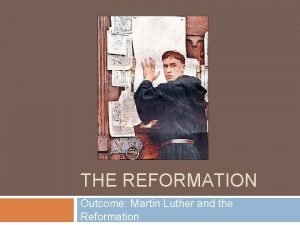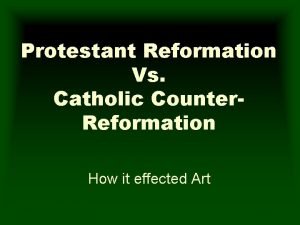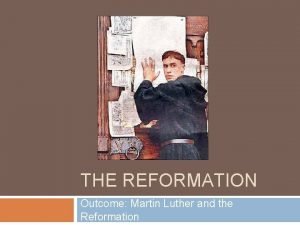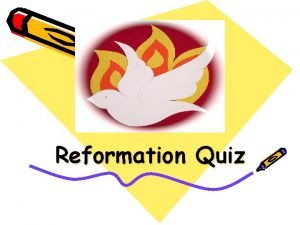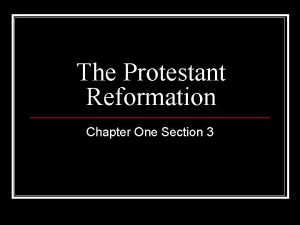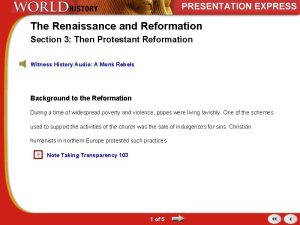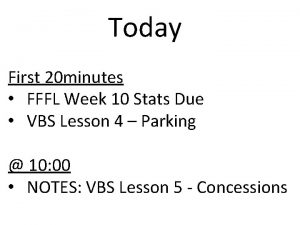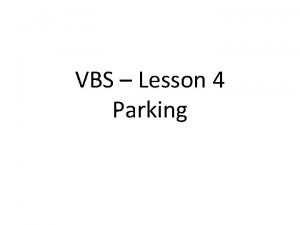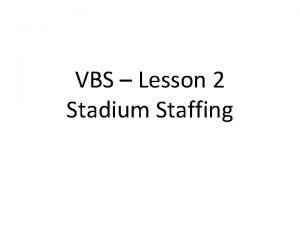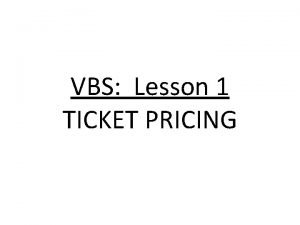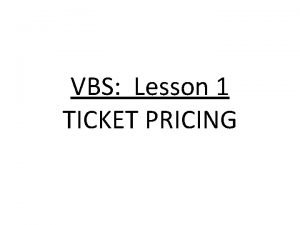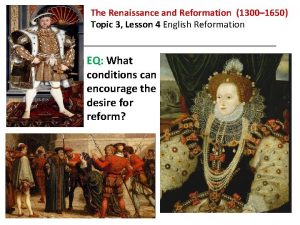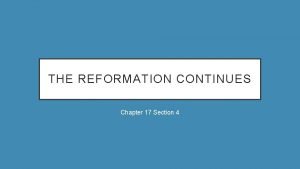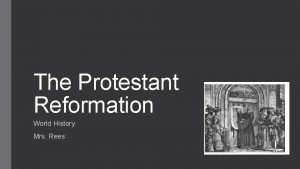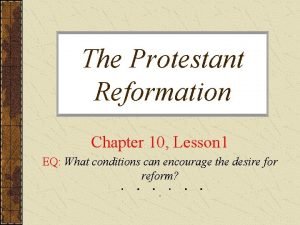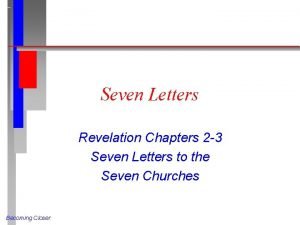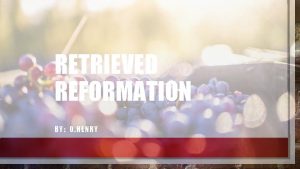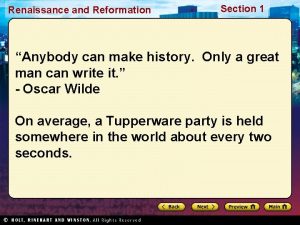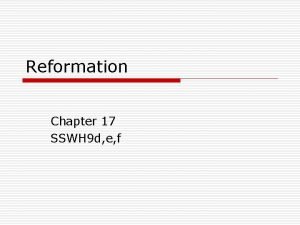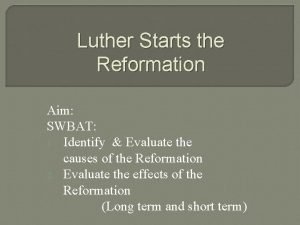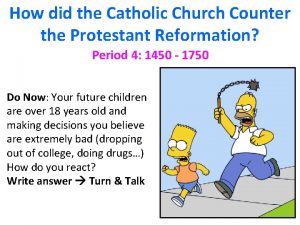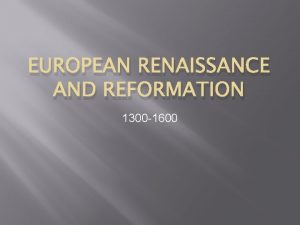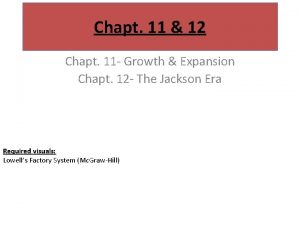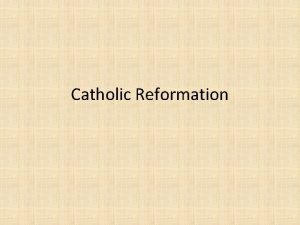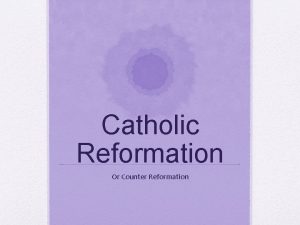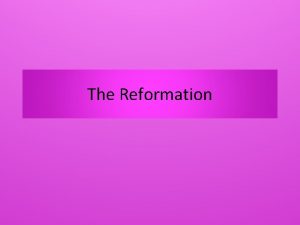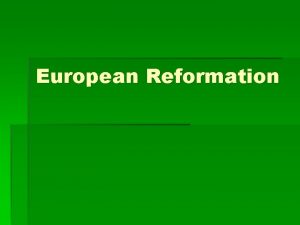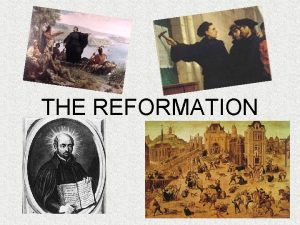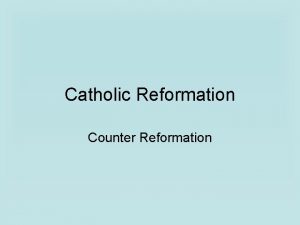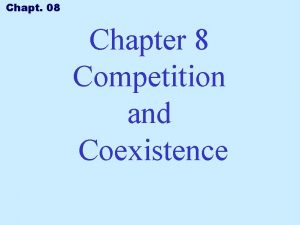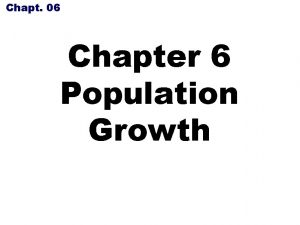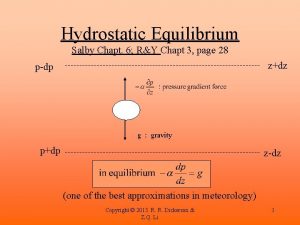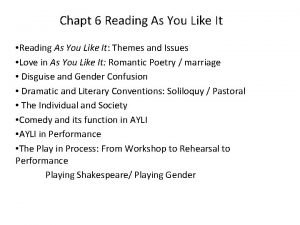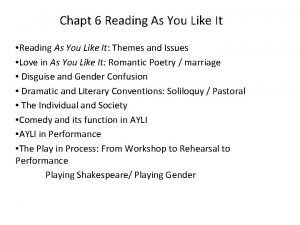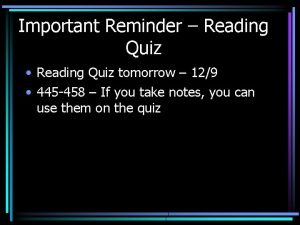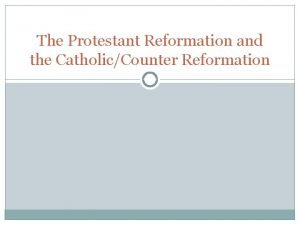Chapt 14 The Reformation 1 Reading Quiz 2

















































































- Slides: 81

Chapt. 14: The Reformation 1. Reading Quiz 2. Discuss Renaissance contextualization 3. HTS – interpretation HW: outline – “Martin Luther and the Birth of Protestantism” (p. 456 – 466)

Why the Reformation? n Renaissance Popes- too concerned with worldly affairs n Church abuses: n excessive lifestyle n clergy and nepotism n illiteracy and uneducated n Alex VI- 5 kids before Papacy n People expected higher standards n strict standards

Three disorders: 1. Clerical immorality – non-practitioners of celibacy; drunkenness, gambling, etc 2. Clerical ignorance – uneducated, illiterate 3. Clerical pluralism / absenteeism – holding many positions (benefices) at once, collecting incomes for all, and being absent from parishes or sees. *The mixing of civil service / clerical jobs – treasurers, royal councilors, diplomats, judges

A Call for Reform – some attempts • Many lower level spiritual groups and individuals called for reform at this time: Cardinal Francisco Jimenez de Cisneros in Spain; The Brethren of the Common Life” in Holland, became a true religious Revival; processions, pilgrimages, bequeathing money to the church in wills. • Pope Julius II called the ecumenical council from 1512 – 1517. They wanted higher standards for education, and elimination of bureaucratic corruption. • The Imitation of Christ – devotional book by Thomas Kempis - mimic simple life of Christ

Dissent not Crushed n Laity more knowledgeable n Postal service, printing press spread information n Literacy increased n Rome lost some control over church offices (Pragmatic Sanction / Concordat) n City, regional govt. growing

Historical Thinking Skill Interpretation • Describe, analyze, and evaluate the different ways historians interpret the past. • Understand the various types of questions historians ask. • How the circumstances and context of each historians work shapes their interpretation of the past and historical evidence. • Types of sources: encyclopedias, chronologies, biographies, journal articles, books written after the time period, abstracts, paraphrased quotations, dictionaries, and textbooks, newspaper articles about previous events *Different from argumentation in that you are not framing the question they are answering; you are determining how they are interpreting an event to have happened/been shaped.

Chapt. 14: The Reformation 1. Finish/Discuss HTS: interpretation 2. Discuss Martin Luther 3. HTS: Causation & Analyzing Evidence HW: outline – “Germany and the Protestant Reformation” (p. 466 - 470)

Protestants n “protesters” n Religious thinkers who challenged the authority of the Catholic Church n Began the Reformation- movement to reform the Church n John Wycliffe, Jan Hus- early reformers who believed church worldly and corrupt

Early Calls for Reform n John Wycliffe (1330 -1384) n Questioned the authority of the pope n Jan Hus (1370 -1415) n Criticized the vast wealth of the Church n Desiderius Erasmus (1469 -1536) n Attacked corruption in the Church

Sale of Indulgences n Indulgences= Church pardons n. Sold for profit (fundraising) n. Took the place of good works forgiveness of sin n. People believed they were guaranteed entrance into heaven n. Began as reward for service in the Crusades

Johann Tetzel – Sermon on Indulgences “letters of safe conduct from the vicar of our Lord Jesus Christ” “Each mortal sin = seven years penitence after Confession either in this life or purgatory” • If you buy these indulgences, you are cleared of all Penalties and sins

Martin Luther

Martin Luther n Leader of protest against the Church n German monk n Challenged Church to debate in 95 Theses n Oct. 31, 1517 nailed to the Church in Wittenberg n Tetzel- selling indulgences to rebuild St. Peter’s in Rome

Protestant Teaching: Justification by Faith Alone n The Bible is the only source of truth. n People can read and understand the Bible themselves. n Salvation comes Luther’s Bible only through faith in Christ.

Luther’s Fate n 1521 Luther was excommunicated n Ordered to give up his beliefs n Luther burned order n Luther called to Imperial Assembly in Worms by the Holy Roman Emperor, Charles V n Luther declared outlaw and heretic n Luther goes into hiding in Germany (Frederick of Saxony) where he translates the Bible

https: //www. youtube. com/watch? v=dt 5 AJr 0 wls 0

Luther Gains Followers n Reasons: (political and religious) n People liked idea of reading the Bible for themselves n People supported attacks on Church n German princes hoped to gain Church land n German princes wanted to show independence from Holy Roman Emperor n Peasants wanted reform and lower Church taxes (wanted Luther’s support in revolting against princes)

Peasant Revolts n. Follow Luther’s changes n. Take away prince’s power n. Issues: laws, customs, taxes n. Goals: political & economic rights, release from serfdom

Luther’s Response n Sympathized but NO support n. Not social revolutionary n“Un-Christian” n Supported princes right to crush n “Render to unto Caesar what is Caesars”- Luther did not support the revolt

Historical Thinking Skill –Analyzing Evidence • Describe, select, and/or evaluate relevant evidence from diverse sources. • Types of sources: written documents, art, architecture, artifacts, oral tradition, etc. • Draw conclusions about the relevance to history. • Focus on the interplay between the content of a source, the author, point of view, audience, and format. • Assess the usefulness, reliability, and limitations of the source as evidence

Chapt. 14: The Reformation 1. Finish/discuss HTS analyzing evidence chart 2. Discuss Protestant Reformation in Germany / videos HW: outline – “The Growth of the Protestant Reformation” (p. 470 -477)

Germany - background • German empire lacked strong central power – Golden Bull of 1356 legalized government of seven Electors. This ended elections within the empire and decentralized power of the Holy Roman Emperor. • Holy Roman Emperor (not to be confused with the Pope) is chosen by the electors and is the heir of Hapsburg Family. 19 year old Charles V. *House of Hapsburg was created when Maximilian I And Mary of Burgundy were married and united both The Netherlands/Belgian area, Spain, and Austria.

HRE & Charles V (until 7: 45, begin again at 9: 15) https: //www. youtube. com/watch? v=MRYz. W 3 BSj 0 I

Spain Austria HRE Burgundian Netherlands

PLUS New World Possessions

Hapsburg-Valois Wars Hapsburg-Bugundian marriage upsets the French because they believe the Burgundian territory is rightfully French territory. Even after the Treaty of Arras in 1482, there were several skirmishes (Maximilian-HRE vs Louis XIFrance), many of which occurred within Germany. This continued through the reign of Charles V. This conflict evolved from political war into a partially religious in nature.

Revolts in Germany n Luther urges German princes to revolt; princes use Protestantism as justification for rebellion against HRE n HRE Charles V uses military measures n Turns on Protestant German princes n Protestant German Princes form Schmalkaldic League as defensive alliance n Had taken land from Church n Charles ultimately had no help from Catholic princes

Response to Protests n Charles needs the support of all of his princes to help in the fight against the Turks who invade Vienna in 1529. n In 1530, Charles V orders all princes to imperial Diet in Augsburg n People must revert back to Catholicism n Church will get land back n In 1555, Charles gives in and grants the Peace of Augsburg – “he who owns lands determines religion” n Lutheranism, Catholicism n Calvinism other forms of Prot. outlawed

Response to Protests n Charles was not happy with peace n Wanted unity, not division n Attached to Middle Age ideas (feudalism, chivalry, Church)

Schmalkaldic Wars https: //www. youtube. com/watch? v=Id. HRyy. U 0 KLY

Chapt. 14: The Reformation 1. Reading Quiz 2. “Afternoon Tea” 3. Discuss other reformers/English Reformation HW: outline – “The Catholic and Counter Reformation” (p. 477 – 484)

Other Reformers

Zwingli n Led Swiss Reformation, the “People’s Priest” n Erasmus’ New Testament n End celibacy, clergy had right to marry n Believe only what has Scriptural proof n Tradition and practices questioned n Transubstantiation (consubstantiation) n Purgatory n Sermon not Eucharist was more important

Calvinism n 1536 John Calvin, a French religious scholar, joined reformers in Geneva, Switzerland developed Protestant belief system called Calvinism n Huguenots- French Calvinists

Calvin’s teachings n Bible is the supreme authority in matters of faith n Men & women are insignificant and sinful by nature n Predestination- belief certain people are chosen by God for salvation, the “elect” n Only way to enter heaven n Hard work, devotion might be signs of God’s grace n Salvation can not be earned

Calvinism in practice Publishes The Institution of the Christian Religion (1536, 1559) n Geneva was a holy city n Role of government: Theocracy n Supervise people’s lives- live strictly and solemnly n Those who challenged teachings were persecuted or exiled (religious dissenters were “dogs and swine”) n Missionaries used n Huguenots= French Calvinists

Anabaptists n Greek “to rebaptize” n Radical Protestant group originating in depressed urban areas (Germany)– pacifism n Ancestors of Quakers, Amish & Mennonites n NO infant baptism n Human freedom reflected in adult baptism; religious tolerance n Admitted women to ministry

John Knox n Scottish Protestant n Brought Calvin’s ideas to Scotland, n n nobles support ideas (weakens the power of the monarch [James V]) 1560 (wanted to copy Henry VIII) Laid foundations for Presbyterian Church Presbyters (elders)- laymen who governed community church (not bishops) Book of Common Order Predestination

English Reformation

English Protestantism n Earliest demands for reform were in England n Reform connected with struggle for political power n Henry VIII - Act of Supremacy 1534

Henry VIII v Second son of Henry VII (1509 -1547) v After his elder brother Arthur died, Henry became heir to the throne. v Spain and England wanted to keep their alliance, even w/ Arthur’s death, so Henry married Catherine of Aragon, Arthur’s widow v. Henry claimed that God punished him by denying him a legitimate male heir – in Leviticus, God does threaten childlessness if a man marries his brother’s widow…so Henry came to see this marriage as cursed…

The Break… n Catherine of Aragon only had a daughter (5 children had died) n Henry wanted annulment n Fear: repeat of War of Roses if no heir n Result: wanted to marry Anne Boleyn but Church said no n Pope refused favor: Pope Clement VII was taking orders from HRE Charles V (Catherine’s nephew)

Henry VIII (Tudor 1509 -1547) n Problem: Catholic Church did not allow divorce, Pope Clement VII refused to annul marriage n Result: Henry took steps to remove England from Pope’s authority n Thomas Cranmer- Protestant, appointed Archbishop of Canterbury who annulled marriage

Catherine of Aragon

Anne Boleyn

Pope Clement VII

Thomas Cranmer. The Archbishop of Canterbury Wrote the Book of Common Prayer

Henry VIII… n Devout Catholic when young n Detested Luther, called him “A great limb of the Devil” n Pope called Henry “Defender of the Faith” n Politics would change religious views

Around the Pope… n Ask Parliament to pass law taking away Pope’s power in England n Reformation Parliament- met only when King called n 1533 King married Anne (daughter - Elizabeth) n 1534 Act of Supremacy makes King head of the Church of England n King collected Church moneys n Clergy appointed by king n King and Parliament gain power

The Results… n Chancellor Sir Thomas More refuses to accept Act of Supremacy n “I honor my King but I honor my God more” n More is beheaded n Henry closes monasteries, confiscates land (1/3 of land in England) n Catholics are prosecuted n Land is sold to nobles

The Great Malvern Priory was built in 1085, and averted destruction by Henry VIII in 1541 when the townspeople bought it for 20 pounds, and was a working monastery for over 450 years.

Protestant Reformation n Protestantism grew as a return to Catholicism would take nobles’ land away n Henry remained Catholic - insisted on no changes in rituals and doctrines (celibacy, ornaments) n Thus was born Church of England, or the Anglican Church (ancestor of Episcopalian denomination)

Henry’s Wives #1 – Catherine of Aragon (divorced) – Originally married to Henry’s brother Arthur. 1 daughter (Mary) #2 – Anne Bolelyn (beheaded) – Mistress – married after he got a divorce Catherine. 1 daughter (Elizabeth). She could not produce a Male heir, so Henry looked elsewhere ….

Henry’s Wives #3 – Jane Seymour (died – natural causes) 1 son (Edward VI)

Henry’s Wives #4 - Anne of Cleves –lasted 6 months #5 - Catherine Howard, a 17 year old, who was beheaded for adultery #6 - Catherine Parr – final wife she got along well with all the children

https: //www. youtube. com/watch? v=3 EGz. Hsye 71 c

Edward VI

Mary I (Bloody Mary -1553 -1558) v Edward VI- dies shortly after coronation v. Mary was the daughter of Henry VIII and Catharine of Aragon. v As Queen she attempted to restore Catholicism, and she married the young Philip from Spain. v She also had more than 300 Protestants killed. v None of these actions was popular with the now firmly entrenched Protestant England

Bloody Mary

Elizabeth I (1558 -1603) v The red-haired daughter of Henry VIII and Anne Boleyn, she became England’s greatest leader. v She kept control of England by refusing to marry anyone and playing one noble against another – many hoping to marry the Queen. v Elizabethan Settlement – parliamentary legislation requiring “outward” Co. E conformity • 1563 – Thirty-Nine Articles – basic tenants of the Co. E v She kept religious wars down, advanced exploration, became a patron of the arts, and brought England to the position of world power with the defeat of the Spanish Armada

Elizabeth I

Other Countries • Ireland – 1536 – Irish Parliament approves laws Severing the church from Rome making the English monarch supreme sovereign over ecclesiastical Matters; met with Irish resistance (North v South) • Northern Europe – 1520 Sweden and Norway become Independent from Denmark; Sweden implements Lutheran doctrine; King of Denmark also adopts • Eastern Europe – Lutheranism spread from Germany But initially met resistance in Bohemia from King Ferdinand I (Charles V’s brother). • Poland-Lithuania & Hungary– very ethnically diverse; Lutheranism opposed by Polish king because of anti-German sentiment, but accepted Calvinism; Protestanism spread in Hungary but Catholicism was restored later under Hapbsurg rule.

REVIEW: Beliefs of Protestants n Bible provided all guidance n People should read Bible to find path to faith n People shouldn’t rely on Pope for interpretation of Bible n Changes needed in Church services n Clergy should be allowed to marry

Chapt. 14: The (Counter)Reformation 1. Reading Quiz 2. Discuss Catholic & Counter Reformations 3. HTS – CCOT HW: NO READING but outlines will be checked either tomorrow or Monday. Chapters 13, 14 Test Tuesday?

The Catholic Reformation: aka Trying to stay Relevant through “stimulation of new spiritual fervor” (reforms) AND The Counter-Reformation: aka The Church Strikes Back – reaction to Protestant Reformation, attempts to convince people to come back to the Catholic Church (punishments)


Pope Issues • Clement VII – more interested in material /worldly possessions and luxurious lifestyle than the spread of Protestantism. • Rome is sacked by Charles V in retaliation for the Pope’s lack of support during the Hapsburg-Valois Wars (marks the “end” of the Renaissance) • Clement VII becomes political prisoner of Charles V. • Popes also feared councils set up to reform the church.

Counter-Reformation n Catholic Church began to reform and take action to spread Catholicism n Council of Trent, 1545 -1563, convened by Pope Paul III, held in Italy n Established council to reform the church yet also established an Inquisition in papal states…. .

Pope Paul III (Santa? )

Council of Trent n Met intermittently between 1545 – 1563 n Representatives from all nations invited n Ok’d by Charles V; opposed by French kings n Council (Conciliarists) vs the Pope n Reforms to correct abuses: n Sale of indulgences banned n Tightened discipline for clergy; suppressed pluralism n Only worthy people enter clergy n Seminaries established to train clergy n Encouraged reform of monasteries and convents n Encouragement and practice of lay literacy

Council of Trent n Continued beliefs: n Only Church could explain Bible n Faith and good works needed for salvation n Rejected Lutheran and Calvinist views on transubstantiation n Pope highest and final authority n Marriage as a sacrament but now more strict rules (public vows & witnesses) n No reconciliation with Protestantism

Jesuits n Society of Jesus n Founded by Ignatius of Loyola in 1540 n Duties: n. Keep Catholics in Church n. Persuade Protestants to return n. Evangelical missions all over the world

Ignatius of Loyola

Ignatius of Loyola with Pope Paul III

Women in Reformation n Education – both Catholic and Protestant wrote on religious issues n Reform for Catholic nuns – Angela Merici (Ursuline) and Teresa Avila (Carmelite) n Protestantism interests in middle class n Vernacular & nationalism (anti-Rome)

Teresa of Avila • Carmelite nun – preached poverty, rejection of rents, enclosure, forbade class distinction, rejected racial theory (Grandfather was a new christian), approved of evangelical missions in new world • Known as a spiritual writer: “saw in his hand a long spear of gold, and at the iron's point there seemed to be a little fire. He appeared to me to be thrusting it at times into my heart, and to pierce my very entrails; when he drew it out, he seemed to draw them out also, and to leave me all on fire with a great love of God. The pain was so great, that it made me moan; and yet so surpassing was the sweetness of this excessive pain, that I could not wish to be rid of it. The soul is satisfied now with nothing less than God. The pain is not bodily, but spiritual; though the body has its share in it. It is a caressing of love so sweet which now takes place between the soul and God, that I pray God of His goodness to make him experience it who may think that I am lying”

The Ecstasy of St. Teresa, Gianlorenzo Bernini, 1647

Congregation of the Holy Office - 1542 -Committee of six cardinals with jurisdiction over all Catholics and Inquisition in Rome - It accepted hearsay evidence and sometimes used methods of torture and harsh punishments - Published the Index of Prohibited Books in Rome but not outside in other Italian states (did not inhibit secular learning from those areas).

Effects of Reformation n Religious unity of Europe gone n State strengthened at expense of Church n Spread of education n Printing Press, Jesuits, etc n Middle-class strengthened as Protestant work ethic virtue spread n Catholic church reformed from a corrupt institution to more of an emphasis on mission and evangelical work

Historical Thinking Skills – Continuity and Change over Time CHRONOLOGI CAL REASONING • Recognize, analyze, and evaluate historical continuity and change over periods of time of varying length • Continuity is how history stays the same or is continuous. • Relate patterns to larger historical phases or themes.

Crash Course – Protestant Reformation https: //www. youtube. com/watch? v=1 o 8 o. IELb. Nx. E
 The reformation outcome: martin luther and the reformation
The reformation outcome: martin luther and the reformation Catholic reformation vs counter reformation
Catholic reformation vs counter reformation The reformation outcome martin luther and the reformation
The reformation outcome martin luther and the reformation Pre reading while reading and post reading activities
Pre reading while reading and post reading activities The protestant reformation quiz
The protestant reformation quiz Give up one’s views or beliefs
Give up one’s views or beliefs The renaissance and reformation section 3 quiz
The renaissance and reformation section 3 quiz Hình ảnh bộ gõ cơ thể búng tay
Hình ảnh bộ gõ cơ thể búng tay Slidetodoc
Slidetodoc Bổ thể
Bổ thể Tỉ lệ cơ thể trẻ em
Tỉ lệ cơ thể trẻ em Chó sói
Chó sói Tư thế worm breton là gì
Tư thế worm breton là gì Chúa yêu trần thế alleluia
Chúa yêu trần thế alleluia Các môn thể thao bắt đầu bằng từ đua
Các môn thể thao bắt đầu bằng từ đua Thế nào là hệ số cao nhất
Thế nào là hệ số cao nhất Các châu lục và đại dương trên thế giới
Các châu lục và đại dương trên thế giới Công thức tính thế năng
Công thức tính thế năng Trời xanh đây là của chúng ta thể thơ
Trời xanh đây là của chúng ta thể thơ Mật thư anh em như thể tay chân
Mật thư anh em như thể tay chân Làm thế nào để 102-1=99
Làm thế nào để 102-1=99 Phản ứng thế ankan
Phản ứng thế ankan Các châu lục và đại dương trên thế giới
Các châu lục và đại dương trên thế giới Thể thơ truyền thống
Thể thơ truyền thống Quá trình desamine hóa có thể tạo ra
Quá trình desamine hóa có thể tạo ra Một số thể thơ truyền thống
Một số thể thơ truyền thống Cái miệng xinh xinh thế chỉ nói điều hay thôi
Cái miệng xinh xinh thế chỉ nói điều hay thôi Vẽ hình chiếu vuông góc của vật thể sau
Vẽ hình chiếu vuông góc của vật thể sau Nguyên nhân của sự mỏi cơ sinh 8
Nguyên nhân của sự mỏi cơ sinh 8 đặc điểm cơ thể của người tối cổ
đặc điểm cơ thể của người tối cổ Thế nào là giọng cùng tên?
Thế nào là giọng cùng tên? Vẽ hình chiếu đứng bằng cạnh của vật thể
Vẽ hình chiếu đứng bằng cạnh của vật thể Fecboak
Fecboak Thẻ vin
Thẻ vin đại từ thay thế
đại từ thay thế điện thế nghỉ
điện thế nghỉ Tư thế ngồi viết
Tư thế ngồi viết Diễn thế sinh thái là
Diễn thế sinh thái là Dạng đột biến một nhiễm là
Dạng đột biến một nhiễm là Các số nguyên tố là gì
Các số nguyên tố là gì Tư thế ngồi viết
Tư thế ngồi viết Lời thề hippocrates
Lời thề hippocrates Thiếu nhi thế giới liên hoan
Thiếu nhi thế giới liên hoan ưu thế lai là gì
ưu thế lai là gì Sự nuôi và dạy con của hươu
Sự nuôi và dạy con của hươu Khi nào hổ mẹ dạy hổ con săn mồi
Khi nào hổ mẹ dạy hổ con săn mồi Hệ hô hấp
Hệ hô hấp Từ ngữ thể hiện lòng nhân hậu
Từ ngữ thể hiện lòng nhân hậu Thế nào là mạng điện lắp đặt kiểu nổi
Thế nào là mạng điện lắp đặt kiểu nổi Deductive argument examples
Deductive argument examples Every quiz has been easy. therefore, the test will be easy.
Every quiz has been easy. therefore, the test will be easy. Knowledge matters sponsorships sim answers
Knowledge matters sponsorships sim answers Concessions reading quiz
Concessions reading quiz Ingress & egress reading quiz
Ingress & egress reading quiz Stadium staffing reading quiz
Stadium staffing reading quiz 1ticket pricing
1ticket pricing Chapter 1 night quiz
Chapter 1 night quiz Use of micropipette
Use of micropipette Ticket pricing reading quiz
Ticket pricing reading quiz Quiz 1: reading for entertainment
Quiz 1: reading for entertainment St. louis
St. louis Aims of teaching reading
Aims of teaching reading Intensive reading characteristics
Intensive reading characteristics Definition of guided reading
Definition of guided reading Involves scrutinizing any information that you read or hear
Involves scrutinizing any information that you read or hear What is extensive reading
What is extensive reading What is intensive reading
What is intensive reading Characteristics of intensive reading
Characteristics of intensive reading Reformation
Reformation Luther leads the reformation cause and effect
Luther leads the reformation cause and effect Chapter 17 section 4 the reformation continues
Chapter 17 section 4 the reformation continues Reformation rap
Reformation rap Protestant vs catholic war
Protestant vs catholic war Chapter 16 lesson 1 the protestant reformation answer key
Chapter 16 lesson 1 the protestant reformation answer key Branches of catholicism
Branches of catholicism Reformation
Reformation Climax of three little pigs
Climax of three little pigs Reformation
Reformation Reformation def
Reformation def Luther starts the reformation
Luther starts the reformation Reformation
Reformation Who wrote praise of folly
Who wrote praise of folly
